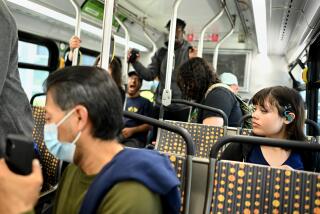Car Phone: Next Step Up From the Beeper
- Share via
You’re a salesman, an attorney, a doctor. You have deadlines to meet, money to make, promises to keep. Valuable time is sliding away creeping along those Southern California freeways.
You can’t be pulling off choked roadways looking for a gasoline station pay phone to check those messages or close that deal.
Solution: the car phone.
“Without it, life would hardly be possible,” said Jim Wolley, a Santa Monica athletic supply salesman, enjoying the overstatement. “You know, it really makes you sound impressive with your customers.”
“I can talk to my girlfriend all the way to work if I want to,” said Randy Phillips, who makes a 45-minute daily shuttle between Pacific Palisades and downtown Los Angeles.
‘A Kick to Have’
“It’s really kind of a kick to have. You can call up the sports lines, a friend, or anything, right in your own car.”
“It’s a prestige thing,” Merry Moore, a customer service representative at Communications Signalling in North Hollywood, said. “For a lot of people, it’s a great toy, but for others it makes them money too. And it can do that.”
Wolley reported a 25% increase in sales since he purchased his mobile phone a little more than a year ago.
The car phone has come a long way since the first primitive one, the Phone Patch, was produced commercially in St. Louis in 1946.
Then it was a product exclusively for the rich and famous. Until the late 1960s and early ‘70s, the mobile phone remained an unnecessary luxury, a contrivance for the wealthy.
100,000 in L.A. Area
Today, they are a hot item, right up there with garage-door openers, a burgeoning technological necessity in many time-conscious minds that have wired themselves into about 100,000 automobiles in the Los Angeles area--almost 75% more than there were a year ago.
“It’s the next step up from the beeper,” said Paul Kim, manager of Just Phones in Beverly Hills.
The advent in 1984 of the cellular telephone is the primary reason for the rapid sales increase.
Unlike the mobile phones of the recent past, the cellular phone can handle many more calls with greater efficiency. It doesn’t fade out driving down an alley way as much anymore.
And with 23 cellular antennaes now in place throughout Southern California, calls can be made virtually from Santa Barbara to San Diego, Moore said.
Costs Come Down
“You can call Sri Lanka as long as you’re within a cellular site area,” Moore said. “But cellular phones are a long way from going nationwide. And to my mind it will never be everywhere. I certainly don’t see them building (a cellular antenna) in Horsebreath, Ark.”
Several years ago, the car phone cost as much as $3,000 to install. Now, a good system can be put in for as little as $800 to $1,000 and it takes less than a half day, said Walter Ryan, manager of Cellular Car Telephones in Burbank.
With a basic service charge of $45 a month and 45 cents a minute between 7 a.m. and 7 p.m. (it’s 27 cents the rest of the time), the average phone bill of mobile phone users runs about $130 a month, Ryan said.
Customers can also lease them for a price ranging from $50 to $135 a month, Moore said.
Like Buying a Stereo
“It’s getting just like buying a stereo system for your home,” Ryan said. “You have to get your basic telephone, the antenna, then have it mounted properly in the car, and you have to have the box that houses the computer unit which handles the billing.”
There is nothing mysterious about the cellular phone. One simply pushes in the number, touches a send button and waits for the ring.
Not many but some mobile customers have their phone rigged so that rather than getting a normal ring inside the car, the horn honks when a caller is calling in.
“I had that changed after a month,” Darleen Resco recalled. “The horn would be going off in the middle of the night. It was like having a haunted car.”
Not all of the bugs have been ironed out yet. If a particular cellular antenna goes down in a particular area, one might have to drive 25 to 50 miles before calls can be made by virtue of another antenna.
“You can lose calls occasionally too,” Moore said. “But it’s a whole lot better than it used to be.”
More to Read
Inside the business of entertainment
The Wide Shot brings you news, analysis and insights on everything from streaming wars to production — and what it all means for the future.
You may occasionally receive promotional content from the Los Angeles Times.










